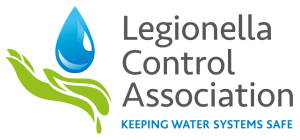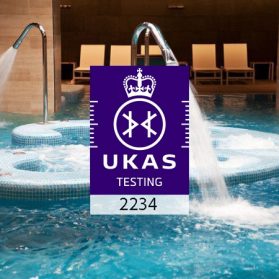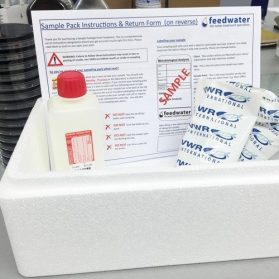Microbiological Testing for Swimming Pools and Spa Pools.
This article contains information lifted from ‘Management of Spa Pools – Controlling the risks of Infection Part 2’.
Routine microbiological analysis should be undertaken to ensure that optimum water treatment conditions are being maintained. While chemical analysis is of benefit to monitor the efficiency of the water treatment system in dealing with the pollution loading, it is important that it is carried out together with microbiological analysis to enable a complete assessment of the water treatment operation and management.
Feedwater provide UKAS accredited pool water analysis from the web shop. A sterile sample kit will be provided with an insulated pre-paid next day return pack.
Information obtained from regular monitoring can indicate:
- whether or not water replacement and backwashing are being undertaken at sufficient frequency
- disinfectant levels are adequate
- show whether or not the operation of the water treatment plant is coping effectively with the bather load
- highlight any unnecessary hand dosing of water treatment chemicals
- provide information on the condition of the filter bed
- provide advanced warning of failure of filter, pumps, valves, etc.
Recent Feedwater Lab Data
Analysis of 211 pool samples taken since the start of 2016 found 10% to be positive for Pseudomonas with the majority NCTC (To numerous to count)
Aerobic Colony Count (TVC) results showed significant out of specification result in 12% of samples at 37C and 14% at 22C.
See our 2014 study on a very large sample of pools showing how its possible to maintain safe conditions. Remember if you don’t test you will never know!
Monitoring for infectious agents
The spa pool manager has the responsibility for ensuring that microbiological samples are taken at appropriate intervals and the results recorded in the spa pool log book together with any remedial actions and follow up samples following an adverse report. In general, a microbiological sample should be taken based on a risk assessment, which would take into account any factors that may have an effect on water quality.
Regular microbiological testing will provide an assurance that operating conditions are satisfactory if:
- it is performed by trained and competent personnel to prevent sample contamination;
- microbiological analysis is carried out in a laboratory accredited for the analysis to ISO17025;
- chemical tests are performed, preferably on site, at the time of sample collection, eg pH value and the concentration of free and total disinfectant in the spa pool water, a review of the maintenance records and bather numbers for the spa pool, information on any mechanical failures, the water appearance, and other untoward events is carried out and noted on the sample submission form.
Microbiological samples for indicator organisms should be taken at least once a month as a routine and quarterly for Legionella. More frequent sampling may be required depending on the risk assessment, eg. if the spa pool is being intensively used and certainly if there are any adverse health effects reported by the bathers.
Spa pools that are situated outdoors have additional demands placed on the disinfection and filtration systems from environmental contamination by dust, debris, etc. So it is important that such factors are taken into account when determining a monitoring schedule.
Microbiological sampling should also be done:
- when a spa pool is first used or recommissioned
- after a report of ill-health following spa pool use
- if there are problems or contamination incidents
- alterations in the treatment/maintenance regimes
Microbiological tests
Tests for indicator organisms should include an aerobic colony count (sometimes called the total viable (colony) count or plate count)), coliforms, Escherichia coli and Pseudomonas aeruginosa. In addition, tests should be quarterly for Legionella.
The aerobic colony count (ACC) after 24 hours incubation at 37°C will give an indication of the overall microbiological quality of the spa pool while the continued presence of coliforms and especially E. coli will indicate the presence of serious contamination arising as a result of a breakdown in the treatment system. The presence of the potential pathogen P. aeruginosa is also an indication of treatment failure with likely colonisation and biofilm formation on the spa pool filter and within other parts of the system. It is a more sensitive indicator of sustained management problems than the coliforms and may be found in their absence but is usually associated with an elevated ACC.
If there are health problems associated with the use of the spa pool, it may be necessary to test for other organisms, based on epidemiological evidence, such as Staphylococcus aureus, Cryptosporidium, Giardia and perhaps viruses. In these circumstances advice should first be sought from the local Health Protection Unit and the microbiologist.
If you require Swimming or Spa Pool water analysis click here.
![]()








